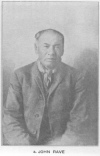
Sacred Texts Native American Plains Index Previous Next
Buy this Book at Amazon.com

The Peyote Cult, by Paul Radin, [1925], at sacred-texts.com
Owing to the great importance of one of the modem cults found among the Winnebago, the so-called Mescal or Peyote, it will be discussed here in some detail. Not only is this cult of great prominence in the life of the modem Winnebago, but as its inception and progress can be followed out in considerable detail it is of great significance for the study of their religion.
The ceremony is generally held in a building called by the Peyote worshipers a church, although it frequently takes place in the open also. In the early days of its organization as many meetings as possible were held. In 1910 there was a tendency to restrict the number and to have them generally take place on Saturday night. In 1913, after the first enthusiasm of the new converts had died out, the author was informed that the meetings were rarely held more than once a week. Around Christmas and beginning with July a series of meetings was held, lasting from a week to 10 days, as a rule. The Christmas meetings were not prominent in 1910, but the July ones seem to have been held from the beginning. They represent, of course, merely a substitution for the older pagan ceremonies and games that were held about that time.
In the early days the ceremony was opened by a prayer from the founder, and this was followed by an introductory speech. Thereupon the leader sang a Peyote song, to the accompaniment of a drum. Then another speech was delivered, and when it was finished the drum and other regalia were passed to the man to the right. This man, in turn, delivered a speech and sang a song, and when he was finished, passed the regalia to the third man, who subsequently passed it to the fourth one. The fourth man, when he was finished, returned it to the leader. In this way the regalia passed from one person to another throughout the night. It not infrequently happens that one of these four gets tired and gives up his place temporarily to some other member of the cult. At intervals they stopped to eat or drink peyote. At about midnight the peyote, as a rule, begins to affect some people. These generally arise and deliver self-accusatory speeches, and make more or less formal confessions, after which they go around shaking hands with everyone and asking forgiveness.

Click to enlarge
a. PEYOTE LEADERS

Click to enlarge
b. BURIAL HUTS

Click to enlarge
a. OLIVER LAMERE

Click to enlarge
b. JOHN RAVE
In 1910 the cult already had a rather definite organization. There was, at every performance, one leader (pl. 54, a) and four principal participants. John Rave (pls. 5, b; 55, b), the Winnebago who introduced the peyote, was always the leader whenever he was present. On other occasions leadership devolved upon some older member. The four other principal participants changed from meeting to meeting, although there was a tendency to ask certain individuals whenever it was possible. The ritualistic unit, in short, is a very definite one, consisting of a number of speeches and songs and in the passing of the regalia from one to the other of the four participants.
During the early hours of the evening, before the peyote has begun to have any appreciable effect, a number of apparently intrusive features are found. These, for the most part, consist of speeches by people in the audience and the reading and explanation of parts of the Bible. After the peyote has begun to have an appreciable effect, however, the ceremony consists exclusively of a repetition of the ritualistic unit and confessions.
There is an initiation consisting of a baptism, always performed by John Rave. It is of a very simple nature. Rave dips his fingers in a peyote infusion and then passes them over the forehead of the new member, muttering at the same time the following prayer:
This is what the Winnebago words mean, although some of the younger members who have been strongly permeated with Christian teachings translate the prayer into, "God, the Son, and the Holy Ghost."
Whenever the ceremony is performed in the open a fireplace in the shape of a horseshoe is made. At one end of this fireplace is placed a very small mound of earth, called by Rave "Mount Sinai," and in front of this a cross is traced in the earth. Upon the small earth mound are placed the two "chief" peyote, the Bible and the staff. The latter, called by Rave the shepherd's crook, is always covered with beadwork, and generally has a number of evenly cut tufts of deer hair on the end and at intervals along its length. The sacred peyote, known as huŋka (i.e., "chief") are exceptionally large and beautiful specimens. They are regarded by a number of people, certainly by Rave, with undisguised veneration.
In addition to the above, there is found a large eagle feather fan, a small drum, arid a peculiar small type of rattle. To my knowledge, this type was unknown among the Winnebago before its introduction by the peyote eaters.